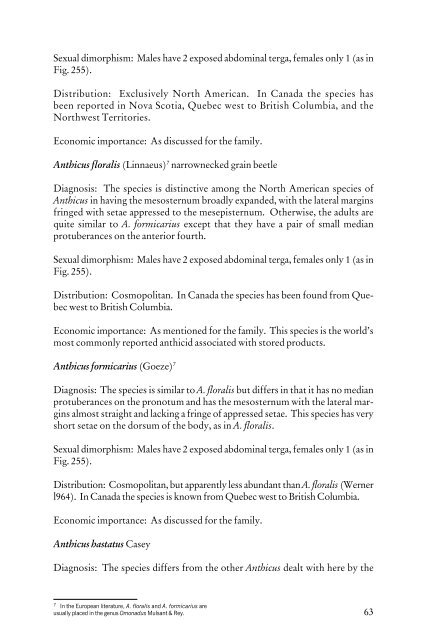Beetles Identification Guide
Beetles Identification Guide
Beetles Identification Guide
You also want an ePaper? Increase the reach of your titles
YUMPU automatically turns print PDFs into web optimized ePapers that Google loves.
Sexual dimorphism: Males have 2 exposed abdominal terga, females only 1 (as in<br />
Fig. 255).<br />
Distribution: Exclusively North American. In Canada the species has<br />
been reported in Nova Scotia, Quebec west to British Columbia, and the<br />
Northwest Territories.<br />
Economic importance: As discussed for the family.<br />
Anthicus floralis (Linnaeus) 7 narrownecked grain beetle<br />
Diagnosis: The species is distinctive among the North American species of<br />
Anthicus in having the mesosternum broadly expanded, with the lateral margins<br />
fringed with setae appressed to the mesepisternum. Otherwise, the adults are<br />
quite similar to A. formicarius except that they have a pair of small median<br />
protuberances on the anterior fourth.<br />
Sexual dimorphism: Males have 2 exposed abdominal terga, females only 1 (as in<br />
Fig. 255).<br />
Distribution: Cosmopolitan. In Canada the species has been found from Quebec<br />
west to British Columbia.<br />
Economic importance: As mentioned for the family. This species is the world’s<br />
most commonly reported anthicid associated with stored products.<br />
Anthicus formicarius (Goeze) 7<br />
Diagnosis: The species is similar to A. floralis but differs in that it has no median<br />
protuberances on the pronotum and has the mesosternum with the lateral margins<br />
almost straight and lacking a fringe of appressed setae. This species has very<br />
short setae on the dorsum of the body, as in A. floralis.<br />
Sexual dimorphism: Males have 2 exposed abdominal terga, females only 1 (as in<br />
Fig. 255).<br />
Distribution: Cosmopolitan, but apparently less abundant than A. floralis (Werner<br />
l964). In Canada the species is known from Quebec west to British Columbia.<br />
Economic importance: As discussed for the family.<br />
Anthicus hastatus Casey<br />
Diagnosis: The species differs from the other Anthicus dealt with here by the<br />
7 In the European literature, A. floralis and A. formicarius are<br />
usually placed in the genus Omonadus Mulsant & Rey.<br />
63
















